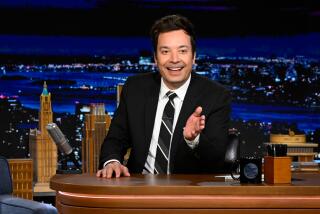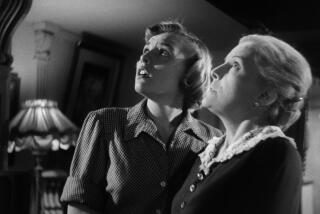IN SEARCH OF THE TV THAT WAS
- Share via
The first film makers thought their one-reelers were perishable as peaches, to be consumed at once rather than preserved. Particularly because the early celluloid film decomposes into a nasty, explosive and inflammable relative of TNT, the studios destroyed prints and negatives of features that seemed to have no further commercial value. Many another print destroyed itself.
Jack Warner once told me ruefully of checking off for destruction a list of films from the vaults--treasures that by the 1960s he dearly wished he had, including a Caruso opera the studio filmed in silent days and intended to show in synchronization with early recordings. It is lost.
The Museum of Modern Art and other institutions here and abroad pioneered in efforts to retrieve the filmed past before it was too late, a work carried on by the American Film Institute. But many an early film, like some of King Vidor’s first silent pictures, evidently exist only as tantalizing titles in printed histories.
Television was a little quicker to get after its past, but not much. And television has the severe problem that in its formative days it was live, recorded not at all or at best on black-and-white kinescopes that were to the original images like bad photostats of a painting.
Last year I had a chance to watch a cassette of a black-and-white kinescope of a live, color, musical version of Thornton Wilder’s “Our Town,” directed by Delbert Mann and broadcast in 1956 with Frank Sinatra as the host-stage manager and Paul Newman and Eva Marie Saint as its young lovers.
The original score was by Sammy Cahn and Jimmy Van Heusen and included “Love and Marriage.” It was an RCA effort to promote the sale of color sets, and even in contrasty and faded black and white, it was thrilling to see. The kinescope, I was told, had been metaphorically if not literally retrieved from a wastebasket, about to be discarded as unneeded.
The Museum of Broadcasting in New York, opened in late 1976 under a personal grant from William S. Paley of CBS to locate and preserve television and radio’s past (and present), has been compiling lists of shows it dearly wishes it had but can’t find.
Just to read the lists is, for those of a certain generation, to be drenched in memory--of the contents but also of those small screens, the maddeningly snowy pre-cable reception and, west of Chicago, those pre-coaxial cable kinescopes that were like peering through pieces of wet toast.
The museum’s first list included the original production of Gian-Carlo Menotti’s “Amahl and the Night Visitors” from Christmas, 1951, and luckily a copy of it turned up.
But still missing is, for example, the premiere broadcast of “The Tonight Show” (Sept. 27, 1954), with Steve Allen hosting. Most of the “Tonight” shows from the ‘50s and ‘60s have been lost or destroyed, says the museum, including Jack Paar’s historic walk-off and Johnny Carson’s no less historic debut (Groucho Marx introduced him).
Super Bowl I (Jan. 15, 1967) was videotaped by not one but two networks . . . and erased. The first televised NFL championship game is missing (Los Angeles Rams vs. Cleveland Browns, Dec. 23, 1951).
The first televised presidential election coverage (Harry Truman versus Thomas E. Dewey) in November, 1948, can’t be found. Neither can the first televised presidential address from the White House (Truman on Sept. 30, 1947).
Ernie Kovacs, the first comedian to make full use of the trickeries of the medium, did his first series, “Three to Get Ready,” from a Philadelphia station, WPTZ, in 1950-51. The museum would dearly love to get hold of any portion of it.
The televised version of “The Petrified Forest” (Sept. 20, 1955), with Humphrey Bogart reprising his film role, is missing, and the museum has only half the original Studio One version of “Twelve Angry Men.”
Robert Batscha, president of the museum, said a telecast of the opening of the New York World’s Fair on April 20, 1939 (with Gen. David Sarnoff and President Franklin D. Roosevelt on hand), is regarded as the start of commercial TV broadcasting. The event is presumably lost to history, except in stills.
Unavailable as well is a telecast from Oct. 17, 1941, which originated in New York and was carried in Philadelphia, thus becoming the first network show.
The museum has just totted up a supplemental list of missing pleasures. It includes “The Jonathan Winters Show” (Oct. 23, 1956), an early use of videotape. “The Damon Runyon Memorial Fund” (April 9, 1949) has its own distinction--it was the first telethon, hosted by Milton Berle.
“The Storm” (1950-53) was an early series by Rod Serling, of “Twilight Zone” fame. It was produced in Cincinnati. The museum has only one episode of “Nightbeat” from 1955, the famous open-pore interview series conducted by Mike Wallace.
There were several pilot episodes of “All in the Family,” done between 1968-71, that the museum would like to get its hands on. And for a program of lasting reverberations, there is the May 4, 1957, “Rock ‘n’ Roll Show,” with Alan Freed hosting for ABC what is thought to be the first network exposure of the music.
The museum seeks, and I hope it finds, a complete record of the Army-McCarthy hearings from 1954, a series of confrontations that was the most engrossing and important reality-drama the medium had watched until that time and that dominated our days, for weeks.
Old films keep turning up in private collections and in foreign countries, with title cards in Hungarian or Croatian. It may be there are other kinescopes, like the “Our Town,” that have been retrieved from trash bins by loving hands unwilling to see good work lost. You have to hope so. It’s our history, not just the medium’s.
The Museum of Broadcasting is at 1 East 53rd St., New York, N.Y., 10022, phone (212) 752-4690.
More to Read
The biggest entertainment stories
Get our big stories about Hollywood, film, television, music, arts, culture and more right in your inbox as soon as they publish.
You may occasionally receive promotional content from the Los Angeles Times.










